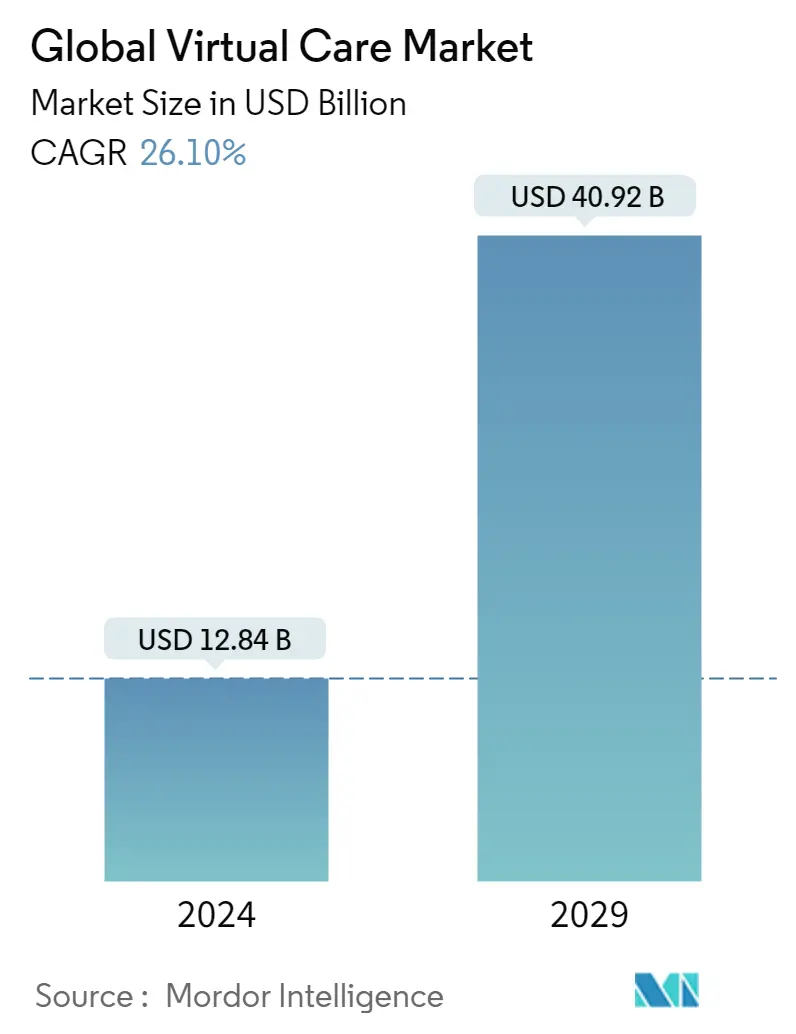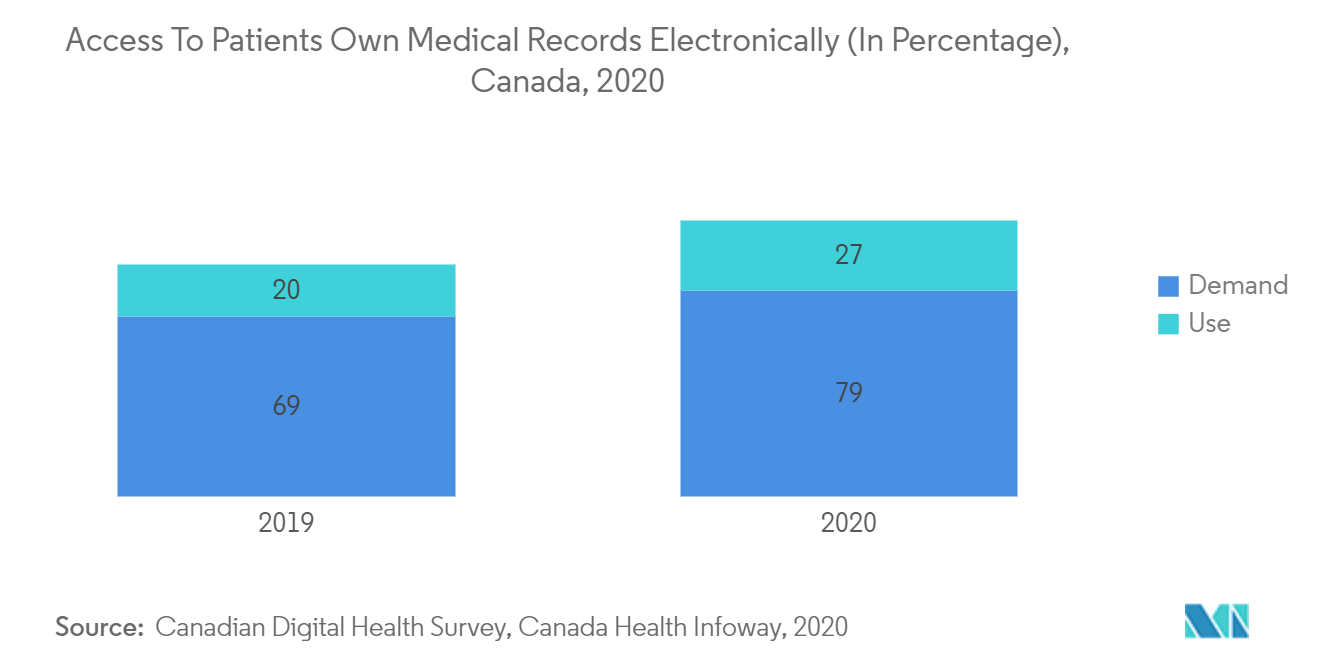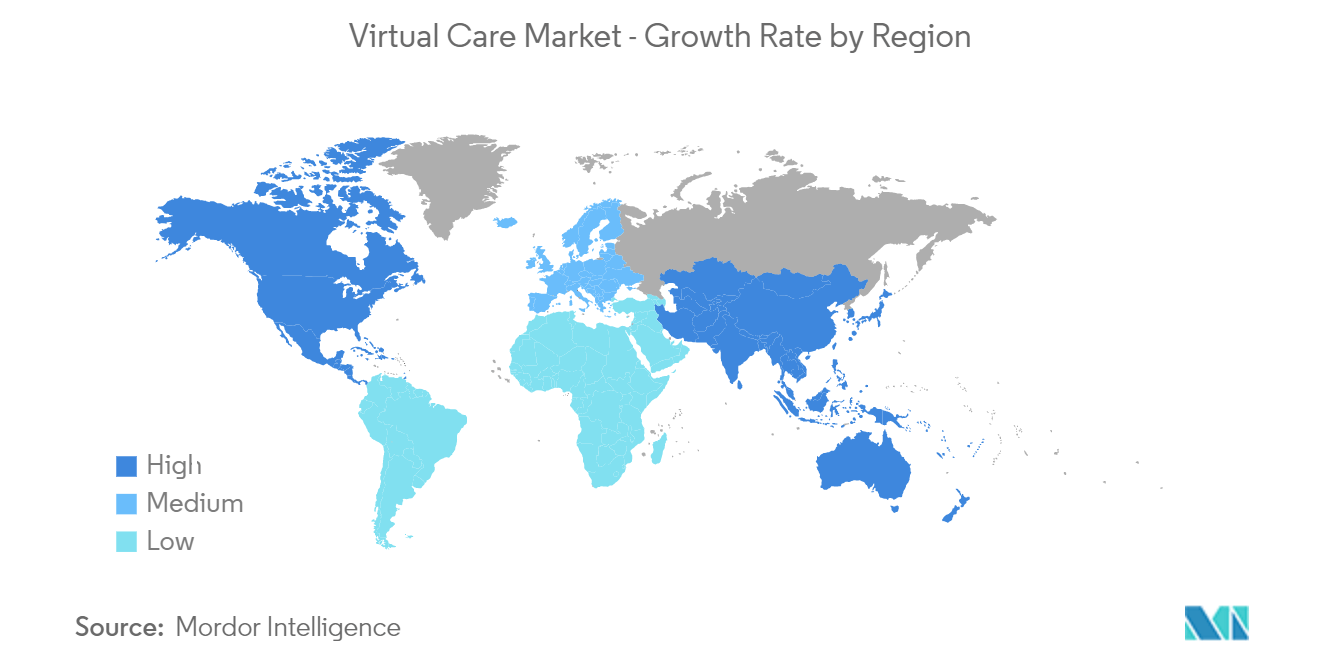Virtual Care Market Size

| Study Period | 2019 - 2029 |
| Market Size (2024) | USD 12.84 Billion |
| Market Size (2029) | USD 40.92 Billion |
| CAGR (2024 - 2029) | 26.10 % |
| Fastest Growing Market | Asia-Pacific |
| Largest Market | North America |
Major Players
*Disclaimer: Major Players sorted in no particular order |
Virtual Care Market Analysis
The Global Virtual Care Market size is estimated at USD 12.84 billion in 2024, and is expected to reach USD 40.92 billion by 2029, growing at a CAGR of 26.10% during the forecast period (2024-2029).
The COVID-19 pandemic had a positive impact on the virtual care market. The pandemic has increased the adoption of virtual care assistance among people of all age groups. Initially, the concept of virtual care was restricted to certain age groups, such as youngsters. However, with the advent of COVID-19, the term "virtual care" gained significant prominence among all patients, irrespective of their age. For instance, as per the survey conducted by the Canadian Medical Association (CMA) in June 2020, during the COVID-19 crisis, 47% of Canadians used "virtual care" such as phone calls, emails, messages, or videos during the outbreak. Ninety-one percent indicated they were incredibly satisfied with their visit. The same source further stated that 34% of individuals who required advice during the pandemic contacted their doctor by phone. However, only 10% saw a doctor in person, 6% went to a walk-in clinic, and 5% went to an emergency department. Furthermore, according to Canada Health Infoway, about 4% of primary care visits in Canada were done remotely (by phone, video, text, or app) before the pandemic was declared. Therefore, such instances indicate the demand for virtual care solutions bolstered during the pandemic phase.
Furthermore, the mutual advantages offered by virtual care for both doctors and patients are one of the major factors driving the market's growth. Through virtual care, patients can undergo consultation from home. It also helps to bridge the gap between patient and doctor, as doctors can reach out to more patients virtually rather than through physical consultation. In addition, virtual care is much more inexpensive than physical consultation as no traveling costs or waiting time are involved. The rising adoption of virtual care has encouraged many key and small players to launch services related to virtual care. For instance, in November 2021, LifeMD launched its virtual care platform to enable affordable and accessible healthcare 24/7 to patients globally. Likewise, in April 2022, with a USD 300 million Series D investment led by growth equity company General Atlantic, Biofourmis, a pioneer in virtual care and digital medicine, achieved unicorn status. Biofourmis intends to expand its virtual care offerings with this financing. This involves providing individualized and predictive in-home care to an increasing number of acutely ill patients and expanding Biofourmis Care, its virtual specialist care service, to patients with complicated chronic diseases. Parallelly, Biofourmis intends to fund clinical trials to accelerate the development of digital medicines that collaborate with high-value medications to boost efficacy and build strategic relationships with firms in digital health and virtual-first care ecosystems. Such innovations are anticipated to drive the market over the forecast period.
Therefore, owing to the above-mentioned factors, the studied market is anticipated to witness considerable growth over the analysis period. However, hospital integration issues and the chances of data breaches leading to compromised privacy are likely to impede the market's growth.
Virtual Care Market Trends
This section covers the major market trends shaping the Virtual Care Market according to our research experts:
Home Healthcare Segment is Expected to Witness Significant Growth Over the Forecast Period
The home healthcare segment is anticipated to witness significant growth over the forecast period. With the advent of COVID-19, patients are gradually adopting the virtual care concept. Although the concept already exists in developed countries such as the United States, it is still new in many developing countries. With the onset of COVID-19, virtual care has emerged as one of the easiest and most utilized modes of consultation among all age groups.
The lack of beds and high consultation waiting time in hospitals have majorly contributed to the shift of the physical to virtual care trend. For instance, the National Health Service in the United Kingdom published a guideline on establishing technology-enabled virtual wards for patients in December 2021. Virtual wards enable patients who would normally be admitted to the hospital to receive the acute care, remote monitoring, and therapy they require in the comfort of their own homes, including care homes. The organization further stated that by making the appropriate information available to the right people at the right time, technology might help organizations lessen the stress on frontline workers and enhance patient outcomes. Virtual wards are appropriate for a variety of illnesses that can be handled and monitored safely and successfully at home. Many communities have created or are working to create virtual wards for a variety of patients, including those with respiratory issues, heart failure, or acute exacerbations of a frailty-related ailment. In addition, there is no risk of getting any infections during virtual visits, while in physical visits, the risk is comparatively high. Therefore, such instances indicate that the home healthcare segment is expected to witness significant growth over the forecast period.

North America is Expected to Dominate the Virtual Care Market Over the Forecast Period
North America is expected to dominate the market owing to factors such as increasing adoption of virtual care models, expanding the geographical reach of the companies, a surge in the number of virtual healthcare start-ups, and growing service launches by key and small players operating in this region. For instance, in February 2022, Clinicians launched the first virtual care service, KixCare, for kids in Canada. Therefore, such developments are anticipated to propel the market's growth in this region.
Moreover, key service launches, government initiatives toward virtual care, and a high concentration of market players or manufacturers' presence in the United States are some of the other factors driving the growth of the virtual care market in the country. For instance, as per the report published by the US Department of Health & Human Services (HHS) in February 2022, HHS awarded around USD 55 million to increase virtual health care access and quality through community health care centers. The funding will help the health centers adopt the latest innovations and technologies to expand facilities for primary care for underserved communities. Likewise, in May 2022, CVS Health introduced CVS Health Virtual Primary Care, a new virtual care solution accessible via a single digital platform. For a more coordinated and consumer-centric health care experience, the solution integrates CVS Health's services, clinical expertise, and data. Hence, such factors are anticipated to propel the market growth in the United States over the forecast period. Therefore, owing to the aforementioned factors, the growth of the studied market is anticipated in the North American region.

Virtual Care Industry Overview
The virtual care market is fragmented in nature due to the presence of several companies operating globally as well as regionally. The competitive landscape includes an analysis of a few international as well as local companies that hold the market shares and are well known, including Teladoc Health, Inc., American Well Corporation, United HealthCare Services, Inc., CVS Health, MDLIVE, Medocity, Inc., Amazon.com, Inc., VirtualHealth, General Electric Company, and Cerner Corporation, among others.
Virtual Care Market Leaders
-
Teladoc Health, Inc.
-
CVS Health
-
American Well Corporation
-
MDLIVE
-
Oracle Corporation (Cerner)
*Disclaimer: Major Players sorted in no particular order

Virtual Care Market News
- In May 2022 CVS Health launched CVS Health Virtual Primary Care for its CVS Caremark members. The CVS Health Virtual Primary Care is a telehealth service that gives members an on-demand virtual care link to primary care providers, as well as urgent care, chronic care management, and behavioral care services, along with other services.
- In November 2021, TalktoMira, Inc. launched four new virtual care services for its members through Mira Health App, and as per the company, the members will be able to access virtual urgent care 24/7/365 and connect with a provider from anywhere in the Unitd States, avoiding disruptive trips to care sites and wait times in offices.
Virtual Care Market Report - Table of Contents
1. INTRODUCTION
- 1.1 Study Assumptions and Market Definition
- 1.2 Scope of the Study
2. RESEARCH METHODOLOGY
3. EXECUTIVE SUMMARY
4. MARKET DYNAMICS
- 4.1 Market Overview
-
4.2 Market Drivers
- 4.2.1 Increasing Number of Patients Adopting Virtual Care and Government Initiatives Towards Virtual Care Access
- 4.2.2 Advantages Of Virtual Care and New Service Launches by Market Players
-
4.3 Market Restraints
- 4.3.1 Lack of Physician Support and Hospital Integration Issues Due to Privacy Concerns
-
4.4 Porter's Five Forces Analysis
- 4.4.1 Threat of New Entrants
- 4.4.2 Bargaining Power of Buyers and Consumers
- 4.4.3 Bargaining Power of Suppliers
- 4.4.4 Threat of Substitute Products
- 4.4.5 Intensity of Competitive Rivalry
5. MARKET SEGMENTATION (Market Size by Value - in USD Million)
-
5.1 By Mode of Delivery
- 5.1.1 Video
- 5.1.2 Audio
- 5.1.3 Messaging
-
5.2 By Component
- 5.2.1 Solutions
- 5.2.2 Services
-
5.3 By End Users
- 5.3.1 Home Healthcare
- 5.3.2 Hospitals
- 5.3.3 Others
-
5.4 Geography
- 5.4.1 North America
- 5.4.1.1 United States
- 5.4.1.2 Canada
- 5.4.1.3 Mexico
- 5.4.2 Europe
- 5.4.2.1 Germany
- 5.4.2.2 United Kingdom
- 5.4.2.3 France
- 5.4.2.4 Italy
- 5.4.2.5 Spain
- 5.4.2.6 Rest of Europe
- 5.4.3 Asia-Pacific
- 5.4.3.1 China
- 5.4.3.2 Japan
- 5.4.3.3 India
- 5.4.3.4 Australia
- 5.4.3.5 South Korea
- 5.4.3.6 Rest of Asia-Pacific
- 5.4.4 Middle East and Africa
- 5.4.4.1 GCC
- 5.4.4.2 South Africa
- 5.4.4.3 Rest of Middle East and Africa
- 5.4.5 South America
- 5.4.5.1 Brazil
- 5.4.5.2 Argentina
- 5.4.5.3 Rest of South America
6. COMPETITIVE LANDSCAPE
-
6.1 Company Profiles
- 6.1.1 Teladoc Health, Inc.
- 6.1.2 American Well Corporation
- 6.1.3 United HealthCare Services, Inc.
- 6.1.4 CVS Health
- 6.1.5 MDLIVE
- 6.1.6 Medocity, Inc.
- 6.1.7 Amazon.com, Inc.
- 6.1.8 VirtualHealth
- 6.1.9 General Electric Company
- 6.1.10 Oracle Corporation (Cerner)
- *List Not Exhaustive
7. MARKET OPPORTUNITIES AND FUTURE TRENDS
** Subject To AvailablityVirtual Care Industry Segmentation
Per the report's scope, virtual care generally enables patients to undergo online consultation with doctors from anywhere. Virtual care generally includes consultation through live audio, video, and instant messaging as a mode of communication with the patients remotely. The virtual care market is segmented by mode of delivery (video, audio, and messaging), component (solutions and services), end user (home healthcare, hospitals, and others), and geography (North America, Europe, Asia-Pacific, Middle East and Africa, and South America). The market report also covers the estimated market sizes and trends for 17 countries across major global regions. The report offers the value (in USD million) for the above segments.
| By Mode of Delivery | Video | |
| Audio | ||
| Messaging | ||
| By Component | Solutions | |
| Services | ||
| By End Users | Home Healthcare | |
| Hospitals | ||
| Others | ||
| Geography | North America | United States |
| Canada | ||
| Mexico | ||
| Geography | Europe | Germany |
| United Kingdom | ||
| France | ||
| Italy | ||
| Spain | ||
| Rest of Europe | ||
| Geography | Asia-Pacific | China |
| Japan | ||
| India | ||
| Australia | ||
| South Korea | ||
| Rest of Asia-Pacific | ||
| Geography | Middle East and Africa | GCC |
| South Africa | ||
| Rest of Middle East and Africa | ||
| Geography | South America | Brazil |
| Argentina | ||
| Rest of South America |
Virtual Care Market Research FAQs
How big is the Global Virtual Care Market?
The Global Virtual Care Market size is expected to reach USD 12.84 billion in 2024 and grow at a CAGR of 26.10% to reach USD 40.92 billion by 2029.
What is the current Global Virtual Care Market size?
In 2024, the Global Virtual Care Market size is expected to reach USD 12.84 billion.
Who are the key players in Global Virtual Care Market?
Teladoc Health, Inc., CVS Health, American Well Corporation, MDLIVE and Oracle Corporation (Cerner) are the major companies operating in the Global Virtual Care Market.
Which is the fastest growing region in Global Virtual Care Market?
Asia-Pacific is estimated to grow at the highest CAGR over the forecast period (2024-2029).
Which region has the biggest share in Global Virtual Care Market?
In 2024, the North America accounts for the largest market share in Global Virtual Care Market.
What years does this Global Virtual Care Market cover, and what was the market size in 2023?
In 2023, the Global Virtual Care Market size was estimated at USD 10.18 billion. The report covers the Global Virtual Care Market historical market size for years: 2019, 2020, 2021, 2022 and 2023. The report also forecasts the Global Virtual Care Market size for years: 2024, 2025, 2026, 2027, 2028 and 2029.
Virtual Care Industry Report
Statistics for the 2024 Virtual Care market share, size and revenue growth rate, created by Mordor Intelligence™ Industry Reports. Virtual Care analysis includes a market forecast outlook to 2029 and historical overview. Get a sample of this industry analysis as a free report PDF download.



